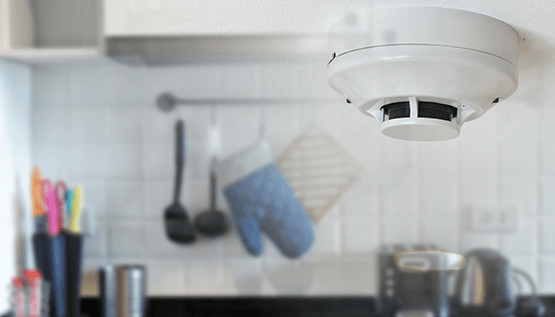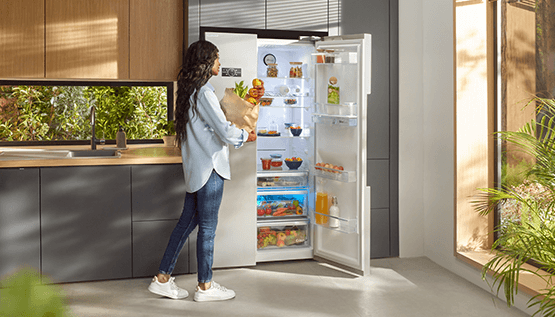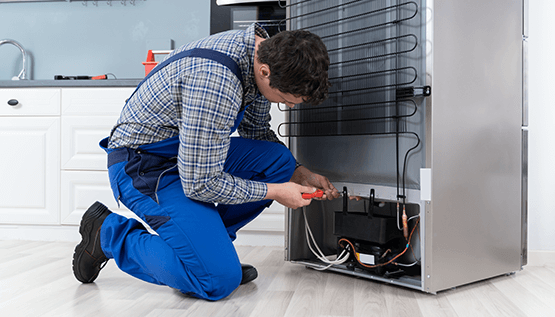Can a Fridge Freezer Go Next to an Oven?
Finding the perfect spot for all your kitchen appliances not only ensures they fit comfortably in your home but also enhances the functioning and practicality of your kitchen. However, when dealing with appliances that operate a vastly different temperatures, such as a fridge freezer and an oven/cooker, careful placement is crucial.

The Risks of Placing a Fridge Freezer Next to a Cooker
When deciding on the best place to place your fridge freezer, it’s important to consider the location of other appliances. Placing your fridge freezer directly next to your oven or cooker can pose potential risks. The placement of your appliances not only affects your kitchen’s workflow, but can also impact the performance of your fridge freezer.
Heat Damage

Heat damage and heat transfer are significant issues that can arise from placing a fridge freezer next to an oven. The proximity of the oven can potentially damage the body of your fridge freezer and raise the ambient temperature around it. This can interfere with the fridge freezer’s ability to regulate temperature effectively, making it harder to keep your groceries fresh. Heat damage can also affect the appliance’s temperature regulation, stability, and durability. If not properly addressed, this overheating and damage can pose a fire hazard.
Lower Efficiency

Fridge freezers are designed to operate in relatively cool environments, so exposure to additional heat - such as from ovens or prolonged direct sunlight - can impact their efficiency. Excess heat can cause the compressor to overwork, leading to increased energy consumption and making it harder for the appliance to keep your groceries fresh. The close proximity of other heat sources can also adversely affect the fridge freezer’s ventilation, reducing its efficiency over time. Proper ventilation is crucial for the optimal functioning of your fridge freezer, so it’s important to consider its placement to ensure it operates effectively.
Long-term Effects

Over time, placing a fridge freezer next to an oven can be detrimental to the effectiveness and safety of both appliances. The temperature difference between the two can place a strain on each appliance, leading to increased wear and tear. This can shorten the lifespan of your fridge freezer and result in more frequent repairs or replacements. Improper temperature regulation due to excessive heat can also compromise your food safety and hygiene, potentially leading to bacterial growth or spoiled food that could cause illness
What is the Recommended Distance Between a Fridge and an Oven ?
Positioning your fridge and oven correctly is crucial for both safety and efficiency in your kitchen. Whether you're redesigning your space or setting up in a new home, understanding the optimal distance between these appliances ensures a well-functioning kitchen. Several factors will influence the recommended spacing, including appliance type, size, and ventilation needs. Here's what you need to consider:
Appliance Type: Integrated vs. Freestanding
The type of appliances you have -whether integrated or freestanding -can impact the recommended distance between your fridge and oven. Integrated appliances are built into your kitchen cabinetry, often allowing for a more seamless look and closer proximity. However, even with integrated designs, it's important to ensure that heat from the oven doesn’t negatively impact the fridge's performance. Learn more about buying integrated appliances here.
For freestanding appliances, the general recommendation is to maintain a minimum of 15-30 cm (6-12 inches) between the fridge and oven. This distance helps to prevent the heat from the oven from causing your fridge to work harder, which can decrease its efficiency and lifespan.
Ventilation
Ventilation is another key factor in determining the distance between your fridge and oven. Proper airflow is essential for your fridge to operate efficiently. You should ensure there is at least 5 cm of space behind the fridge and 2 cm on either side for adequate ventilation. Ensuring sufficient space and ventilation can help avoid overheating and maintain appliance efficiency.
Appliance Size
The size of your appliances can also dictate the ideal distance between them. Larger appliances may require more space to ensure they function efficiently without interfering with one another. If you have a large family-size fridge, you might need to provide additional space between it and the oven to account for the larger cooling area and increased ventilation needs.
Safety Considerations
Safety should always be a priority when positioning your fridge and oven. Ensuring there is a buffer zone between the two appliances not only helps with efficiency but also minimises the risk of heat damage or fire hazards. As a rule of thumb, keeping your fridge and oven at least 15-30 cm apart is advisable unless specific appliance guidelines suggest otherwise.
For optimal performance, fridge freezers should be placed in a stable, cool environment. Positioning them next to an oven can compromise their efficiency and durability, making it harder to maintain the correct temperature and potentially shortening the lifespan of both appliances. Thoughtfully placing your kitchen layout and ensuring your fridge freezer is not placed next to our oven is a must, even in smaller spaces.
Did we answer your question?
We are so sorry we were unable to answer your question. You might be able to find the answer you are looking for in the ‘Related Questions’ below. If your query is still unanswered, please head over to our Contact Us page for further assistance.
Search FAQ’s
Search or browse our frequently asked questions to find the answer to your query.




